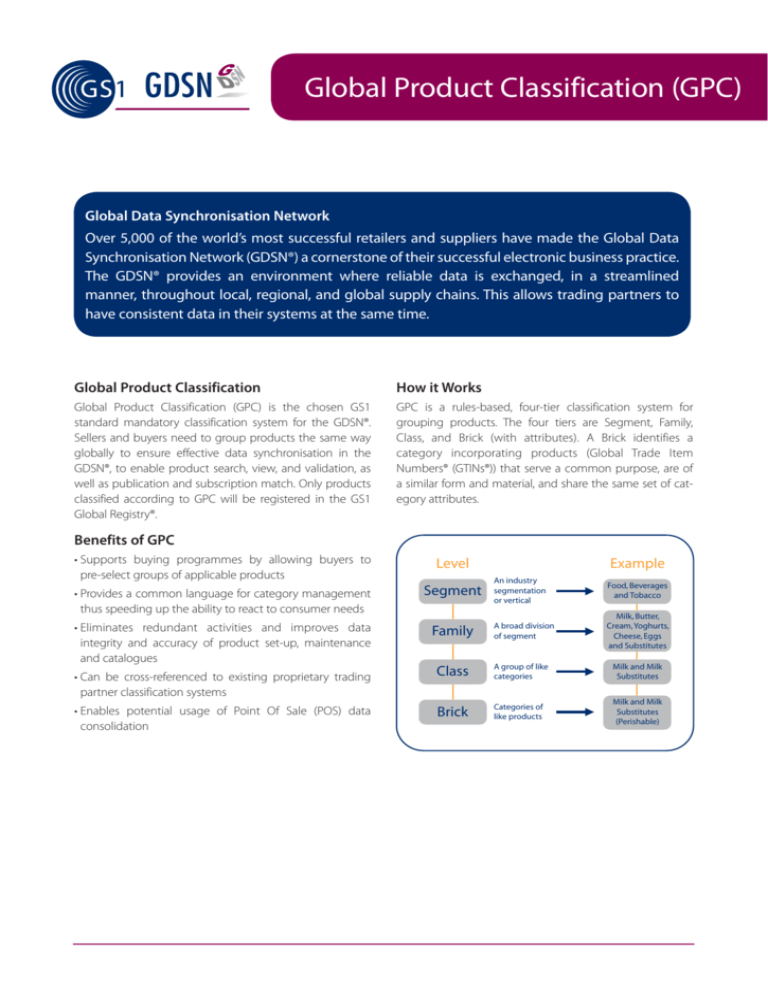
The Global Product Classification (GPC) presents a transformative framework for understanding and managing product data across various sectors. At its core, GPC seeks to streamline product classification, offering myriad advantages that resonate deeply within the broader narratives of efficiency, data integrity, and market adaptability. By delving into the nuances of GPC, one can uncover the multilayered repercussions of its implementation, revealing a spectrum of benefits that extend beyond mere categorization.
One prevalent observation within the contemporary commercial landscape is the ever-increasing complexity of product assortments. As marketplaces evolve, businesses face an avalanche of products that range vastly in type, functionality, and consumer appeal. This complexity often engenders confusion both for companies aiming to optimize their inventory management and for consumers seeking clarity in their purchasing decisions. Herein lies the profound advantage of employing GPC: it offers a cohesive language for all stakeholders involved, effectively mitigating the uncertainties that arise from diverse terminologies and classifications.
First and foremost, the utilization of GPC facilitates a common lexicon that transcends industry silos. Traditionally, businesses operated within isolated ecosystems, each developing proprietary categorizations that exhibited a lack of standardization. This fragmentation not only hindered intra-company communication but also obstructed interoperability between partners and supply chains. By adopting GPC, organizations can harmonize their classification schemas, ensuring an easier exchange of information and fostering collaboration in a way that was previously unfeasible. Such standardization cultivates a rich environment for data-driven decision-making, enabling firms to forge stronger partnerships based on a shared understanding of product information.
Furthermore, GPC enhances the accuracy of product data management. In a world rife with misinformation and inconsistent product descriptions, the advent of a standardized classification system emerges as a beacon of reliability. By employing uniform codes and categories, businesses can reduce the incidence of erroneous data entries that diminish the quality of analytical insights and operational decisions. This precision is particularly crucial in industries where safety and compliance are paramount, as accurate product categorization directly contributes to regulatory adherence and quality assurance. Organizations that embrace GPC are, therefore, positioned to navigate the complexities of compliance with greater agility, safeguarding their reputations and finances alike.
In addition to improving accuracy, GPC streamlines inventory management processes. Real-time visibility into product classifications allows companies to track inventory levels more efficiently, reducing both overstocks and stockouts. When product categories align with GPC codes, it becomes significantly easier to forecast demand and optimize procurement strategies. Consequently, businesses experience not just savings in operational costs but also enhanced customer satisfaction, as they can more effectively meet consumer demands with timely product availability.
Moreover, GPC’s impact extends into the realm of marketing and consumer engagement. When products are classified uniformly, marketing teams can deploy targeted campaigns with greater efficacy. Understanding consumer preferences around categorized products allows for customization of offerings and promotional strategies, ultimately fostering brand loyalty. As consumers navigate an increasingly crowded marketplace, the ability to discern product offerings quickly and clearly leads to more informed purchasing decisions, promoting a sense of confidence and loyalty toward brands that prioritize clarity.
Another significant advantage associated with GPC usage lies in its facilitation of analytics and insights generation. Organizations that leverage standardized product classifications can effectively mine data patterns and trends across categories. This capability means that businesses are not merely reacting to market demands but are actively anticipating shifts based on sophisticated analyses of consumer behavior and sales metrics. GPC enables an organization to become an agile responder in a dynamic economic landscape, positioning them to capitalize on emerging opportunities ahead of competitors.
The integration of GPC also dovetails with the rise of digital transformation initiatives. As businesses increasingly pivot toward data-driven strategies, having a robust product classification system becomes indispensable. GPC provides the scaffolding necessary for sophisticated data architecture, enabling seamless integration of disparate systems and platforms. Organizations can thus embrace innovative technologies, such as artificial intelligence and machine learning, to glean deeper insights from their product data, fostering a culture of continuous improvement and innovation.
However, the road to implementing GPC is not bereft of challenges. Organizations must invest in training and infrastructure to ensure that employees understand and uniformly apply the classification codes. Nevertheless, these investments yield exponential returns in efficiency and accuracy, reaffirming the notion that the benefits of GPC far outweigh the initial hurdles to implementation.
In summation, the advantages associated with the use of the Global Product Classification extend well beyond the realm of simple product categorization. By offering a standardized framework that enhances interoperability, data integrity, and inventory management, GPC addresses pressing challenges within the modern commercial ecosystem. Its implementation serves not just as a mechanism for organization but as a catalyst for strategic growth, allowing businesses to thrive amidst complexities while cultivating lasting consumer relationships. As the marketplace continues to evolve, the GPC stands as an indispensable asset for organizations looking to carve out a competitive edge in an increasingly intricate world.
